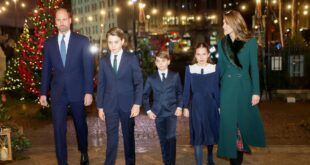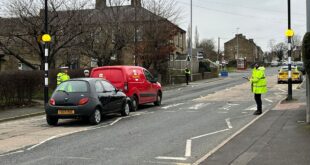THE recent piece in the Telegraph & Argus about the Talbot Hotel’s stone dogs suggested an article about the hotel, which occupied an important place in Bradford’s history.
It shows too how vital inns were in the past to social, economic and political life.
The Talbot Inn is first recorded in a deed of 1671 in Kirkgate, then one of just three thoroughfares in the centre of Bradford, along with Westgate and Ivegate. Behind it were gardens, orchards and a croft of land. It was owned by Peter Sunderland of Leaventhorpe, who had granted a rent charge of £40 on several properties to fund an afternoon lecturer to assist the vicar, a regular payment which wasn’t finally bought out by the Council until 1974.
It was probably rebuilt in the mid-18th century, as were other important Bradford inns like the Bowling Green in Bridge Street and the Sun at the bottom of Ivegate, as the town’s economy grew.
In 1783 it is described in the Leeds Mercury as a ‘large and commodious house’ with good stabling, ‘lately fitted out at considerable expense’ by owner and landlord Hugh Cryer and then run by his widow. In a rate book of 1805, it is the second highest rated property in the town, indicating its scale and importance.
A map surveyed in 1849 shows its position next to the Piece Hall, where the eponymous Yard now is. Note the five inns there at this time, of which the Shoulder of Mutton still trades. They were essential for the merchants who attended the Piece Halls to do business in the sale of worsted cloth. The Talbot itself also provided piece rooms for them. It was also a coaching inn, where you could board the Union for Leeds or Settle and Kendal or the Royal Mail to Leeds or Skipton.
But it would require a much longer article to detail all the uses the inn served. At election time, which could be pretty lively in those days with plenty of drink for thirsty voters and onlookers, it was the headquarters of the Tory party. It hosted the meetings of the Worsted Committee, friendly societies, local government bodies, turnpike trustees, the proprietors of the Leeds and Liverpool Canal, among many.
Perhaps some of the most important gatherings were when Richard Oastler wrote his famous letter in 1830 to the Leeds Mercury about child slavery in Bradford’s worsted mills, ‘innocent victims at the shrine of avarice’. It had prompted a meeting of the worsted spinners there, chaired by John Rand, whose mill occupied the site where the Alhambra was later built.
Although some of his colleagues didn’t like the ‘tone’ of Oastler’s letter, including comparing their overseers to slave drivers in the United States, they resolved to reduce the hours of children’s labour to 11 a day and eight on Saturday. Then in 1833 the Factory Commissioners came to Bradford to investigate conditions and also stayed at the Talbot. Parson Bull of Bierley, another campaigner, addressed the crowds of operatives from the hotel balcony.
But it wasn’t all serious. The Talbot also hosted dancing assemblies and convivial dinners, like the one on Bishop Blaise day, on February 3, 1818, when ‘sixty gentlemen enjoyed there a sumptuous dinner with excellent wines’ and 30,000 took part in the procession to honour the patron saint of woolcombers, still to be seen at the entrance to the former Wool Exchange.
After the Cryers, the inn was run by John Wood and then his widow Rebecca, said to be ‘quaint of speech, but with a keen eye for business’, according to local historian William Scruton, and afterwards by their son, William.
But by the mid-19th century, the centre of Bradford was beginning to be remodelled and rebuilt under the direction of the Corporation and this area of Kirkgate was part of that development. One of these photographs shows the old Talbot shortly before its end, in the mid-1870s (note the advertisement for the roller-skating rink, then a craze in the town) with the dog for which it was named clearly visible above the entrance. This extinct breed of hunting dog gave its name to many inns around the country.
The hotel had been bought by Hammond’s brewery of Bradford who, however, sold it to the Corporation, but then leased the new hotel. The Piece Halls and other surrounding buildings had been swept away and a new link created from Darley Street down to Market Street, where the old Union Passage had been.
The new Talbot Hotel, designed by architects Andrews and Pepper, opened in 1878, described in the Bradford Observer. It had a large bar and smoke room on the ground floor; on the hotel floor: coffee rooms for gentlemen and ladies, commercial, dining, billiard and private rooms. It had 40 bedrooms served by toilets and bathrooms on each floor. The kitchens were on the top floor, to prevent ‘disagreeable smells’.
On the exterior, it now boasted two stone dogs facing on to Kirkgate and Bank Street respectively. The inn’s old well continued to supply ‘the finest water on Bradford’. This is the building in the photograph, taken in the mid-1960s.
I, like many, remember those dogs well and the empty plinths when they were removed, some time after the hotel’s closure in 1974.
I wrote much more about the early history of Bradford’s inns in my book The Public House in Bradford, 1770-1970, out of print now but still available in libraries or for sale online. See also Bradford Pubs for more illustrations, still in print.
* Dr Paul Jennings is author of The Local: A History of the English Pub (new revised third edition), Bradford Pubs and Working-Class Lives in Edwardian Harrogate. Available at Waterstones, WH Smith and online.



